COROS Dura Cycling Computer
Dimensions: 3.92″ x 2.39″ x 0.62″ / 99.5 x 60.8 x 15.7 mm
Stated Weight:
- Body: 97 g
- Mount: 44 g
Blister’s Measured Weight:
- Body: 98 g
- Mount: 46 g
MSRP: $249 USD / $399 CAD
Reviewer: 6’, 160 lb / 183 cm, 72.6 kg
Test Duration: 3 months
Test Location: Washington, British Columbia
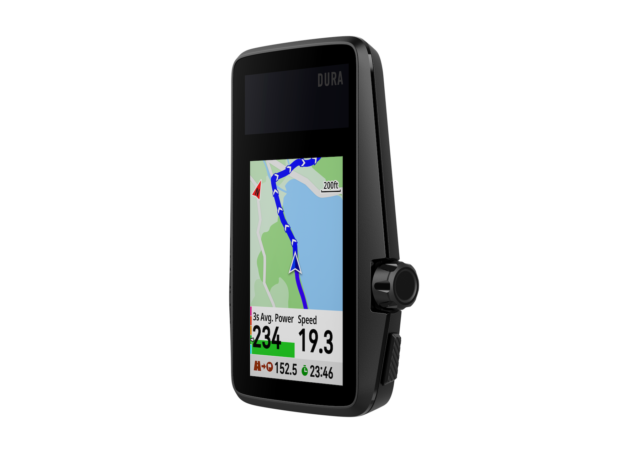
Intro
COROS is a relative newcomer to the GPS wearables game but has already made a big splash. We reviewed their range-topping and feature-packed Vertix 2 watch last year and were very impressed by both its battery life and GPS accuracy.
COROS has done its best to bring those same traits over to its first cycling computer, the Dura. With impressive claims of battery life, solar charging efficiency, and GPS capabilities, the Dura takes on heavy hitters like Garmin and Wahoo, at an attractive MSRP of $249 USD.
Read on as we step through the features of the new COROS Dura.
Design & Features
Rumors have been swirling about COROS’s entry into the cycling computer market for some time now, and the Dura is what they’ve come up with. COROS’ watches are known for good GPS tracking performance and very long battery life, so it’s perhaps unsurprising that the new Dura makes some big promises in those departments — but the Dura also emphasizes a simple user experience that aims to make its cycling computer experience as seamless as possible.
First, let’s dig into the aesthetics. The Dura features a 2.7-inch MIP color touchscreen with a small solar panel positioned above the screen, all wrapped in a rather slim matte black plastic body. A USB-C charging port hides under a cover at the bottom of the body, and folks familiar with COROS watches will recognize the “Digital Dial” scroll wheel in addition to an accompanying back/lap button. That solar panel above the screen does make the Dura’s footprint a bit larger than some other computers with comparably sized screens, but it’s still a fairly sleek and slim device.
COROS includes their own proprietary handlebar mount in the box, but fortunately, they’ve opted to stick with the near-ubiquitous quarter-turn Garmin mount standard. That opens the door to using myriad third-party mounts — bravo to COROS for not inventing new standards here.
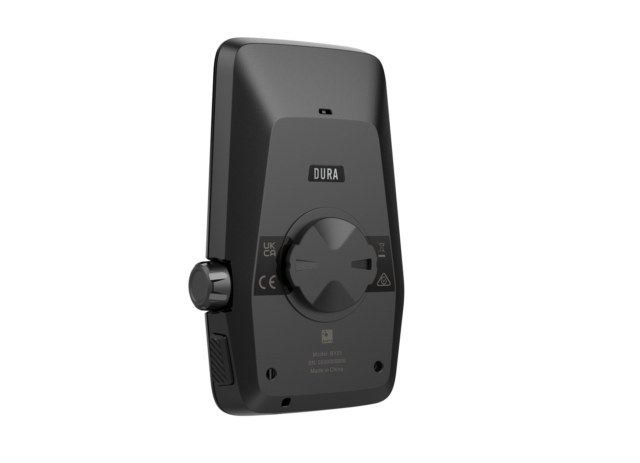
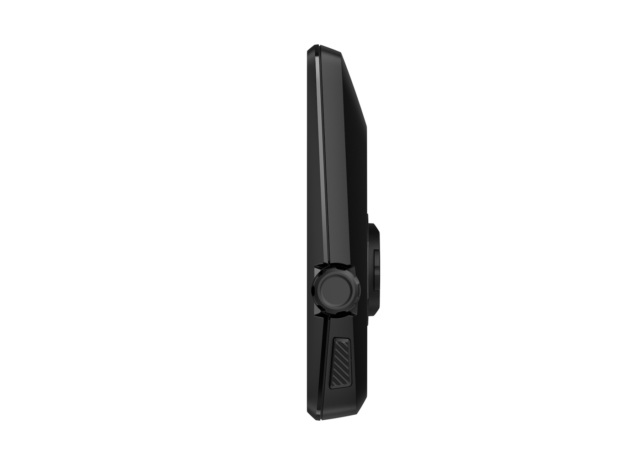
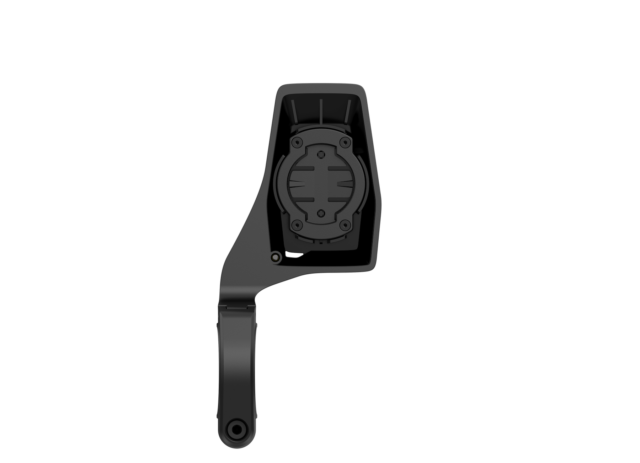
Interface and Compatibility
COROS has emphasized simplicity of use as a major goal for the Dura. The Dura’s home screen displays various cycling activity types that can be selected, including Road, Indoor, Gravel, MTB, E-Bike, and E-MTB. Navigation, Training Plan, and Activity Data are other menu options in; Notifications and a System section are the other main menus for controlling settings, pairing accessories, etc. Activities can be viewed within the computer itself, but the COROS app offers a more feature-rich experience for digesting data after a ride.
The Dura focuses heavily on mapping functionality to provide turn-by-turn navigation and route tracking. COROS has opted to use Google Maps as the underlying map engine, and riders can either draw their own routes in the COROS app or upload routes from services like Strava, Komoot, or any other GPS mapping service. Mid-ride changes to a route will sync from the COROS app to the Dura in just a few seconds. Split screen mode allows riders to view active navigation along with key ride statistics in the same view. Regardless of whether in split screen or just using the statistics screen, COROS brings over the customization from their watches to allow users to customize the panel layout and specific metrics in both views using the app.
From a tracking perspective, COROS supports GPS, GLONASS, GALILEO, BEIDOU, and OZSS satellites. It also offers dual-frequency connectivity which can boost accuracy (at the expense of battery life) and has a barometric altimeter, accelerometer, gyroscope, compass, and temperature sensor all built in. The Dura also has an Auto GPS Selection feature which will choose a satellite based on optimal signal strength, helping both battery life and tracking accuracy.
The Dura is ANT+ compatible, meaning that it can be paired with any ANT+ compatible sensors on the market, such as power meters and the like. It connects with the COROS app and other devices via Bluetooth too, and, like other COROS devices, is compatible with activity tracking platforms like Strava, Komoot, Ride with GPS, and others.
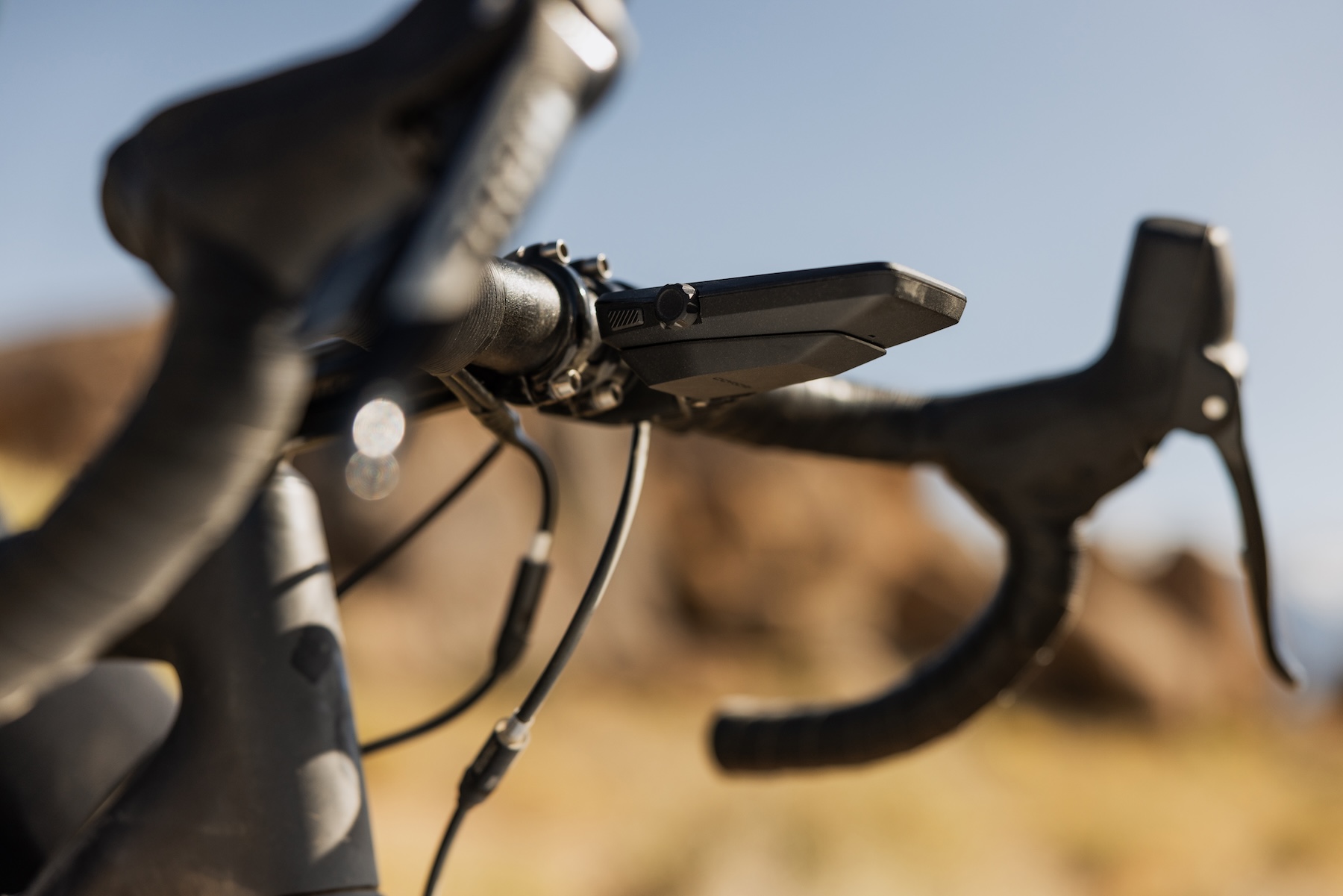
Battery Life
We expected to see a lengthy battery life from the Dura, though I’d say COROS has even exceeded expectations here. With the Dura, COROS promises a massive 120 hours of battery life on a single charge when using a single GPS frequency, though using dual frequency GPS cuts that figure to 70 hours. For those not accustomed to battery life in cycling computers, that’s incredible — Garmin’s top-end Edge 1040 Solar states a 70-hour battery life, and the Wahoo Bolt V2 offers 17 hours.
As though that battery life wasn’t enough, the Dura also features a small solar panel above the screen. While it does make the Dura’s body a bit longer than some competitors, COROS promises solar efficiency of 2 additional hours of run time for every 1 hour of sunlight exposure for the panels. In combination with the impressive battery life, that could very well mean that physically plugging in the Dura could be rarely needed — though we’ll have to do our own testing to find out.
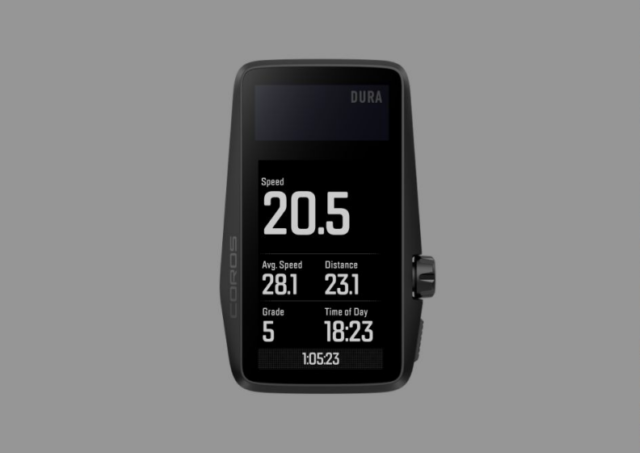
FULL REVIEW
The COROS Dura is first cycling computer from the brand, which is primarily known for its impressive line of GPS watches like the Vertix 2. The Dura faces up against heavyweights like Garmin’s Edge series and Wahoo’s ELEMNT series, but seems like a promising contender with its ridiculously long claimed battery life and relatively affordable price point of $249.99 USD. The Dura offers an impressive set of features on paper, but did COROS meet the mark in real-world use? We’ve had a few months with the Dura and have some thoughts.
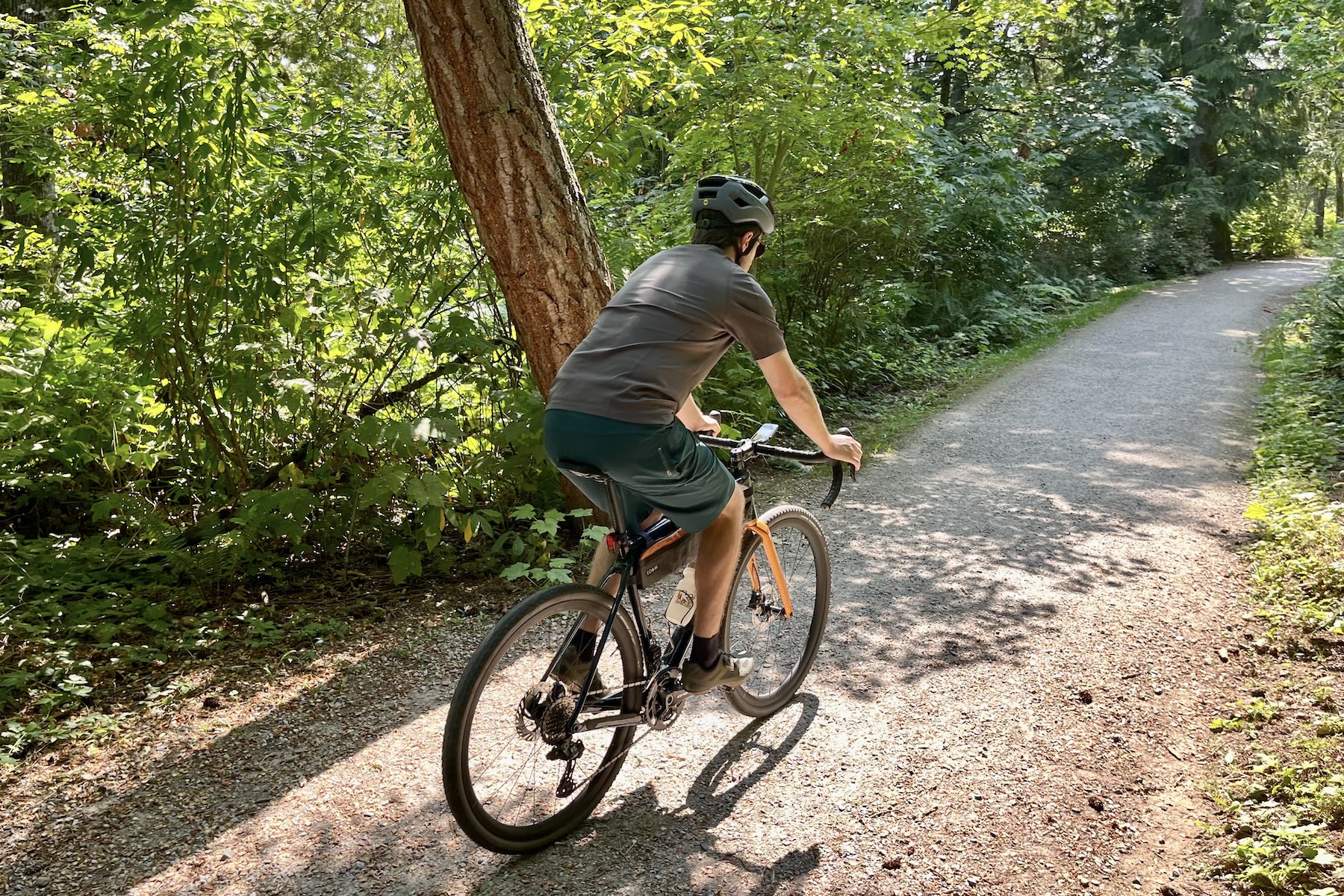
Hardware
The Dura is fairly sizable, with a normal screen size but a slightly enlarged body due to the solar panel at the top. It feels lightweight yet solid in hand, and the touch screen is fairly responsive — though I admit to vastly preferring the tactile experience of buttons given that I’m typically wearing gloves and/or sweaty when using a cycling computer.
On the Dura, there are just two physical controls — a “digital dial” scroll wheel with a push-to-select click feature, and a rectangular lap/back button just below it. On my well-loved COROS Pace 2 running watch, I’ve come to love the digital dial as it seems like an efficient, multi-function use of precious real estate on the small watch case. Despite being a fan of my watch’s digital dial, I think it’s less functional on a larger device like the Dura, which could easily accommodate several sizable buttons. While just about anyone can mash buttons on the fly while riding, the digital dial requires more finesse to accurately scroll while riding, especially off-road. A more standard button layout would have been more functional in my view, and the digital dial more feels like an attempt to share design language with other COROS devices than an optimal use of functional space.
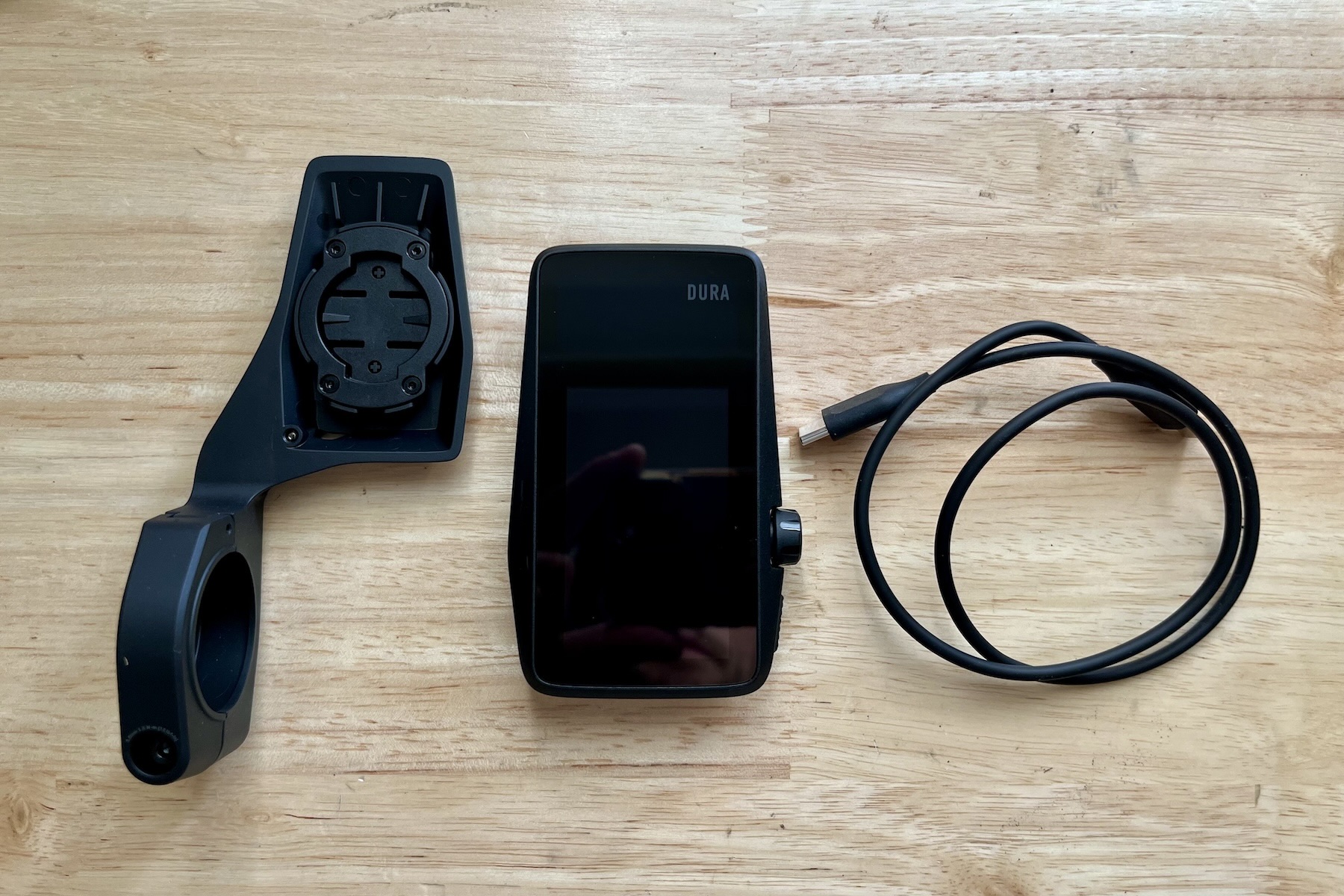
The COROS Dura uses the Garmin mounting standard and comes with a handlebar mount, which puts the Dura out in front of the stem. I mentioned this in our Flash Review as well, but after a bunch of miles with the Dura, I stand by my take that it works well on drop bar bikes, but wouldn’t be my choice for mountain bikes since it puts the computer in harm’s way in the event of a crash. The mount has a solid “click” when the computer is installed, which is a nice touch, but it did develop a bit of a rattle over the course of testing that I couldn’t get rid of. COROS also supplied us with a more basic mount that uses two rubber bands to affix to the handlebar, and though it feels a bit less secure, it worked well when swapping between mountain bikes. I ultimately elected to use a Garmin mount from an Orbea mountain bike — I was able to file down an alignment tab to make it work with non-proprietary stems, allowing me to put the computer squarely over the middle of the stem.
Though it’s not included with the Dura, COROS supplied us with their heart rate monitor strap to complement the computer. Though Bluetooth and ANT+ compatibility means that most other heart rate monitors should work with the Dura, COROS’ own strap sits on the upper bicep and all but disappears in use (at least in my experience) while providing good battery life (claimed 38 hours active, 80 days standby, which closely matched my experience). I could also use my COROS Pace 2 watch as a heart rate monitor, but the arm strap promises better accuracy — and it did seem to deliver on that front, with fewer data anomalies than the built-in monitors on watches seem to have.
Setup & Activity Modes
Setup with the Dura is as easy, or as involved, as you’d like it to be. Though the Dura is ready to simply power on and go right out of the box using the stock activity profiles, there’s also a lot of customization that you can do within the app to make the activity profiles just a bit more tailored to your data needs.
The Dura comes pre-set with Road, Gravel, MTB, E-MTB, E-Bike, and Indoor activity modes. When connected to the COROS app, each of these modes let you customize the display to include your choice of the myriad statistics the Dura can support. For example, in MTB mode, I can select the number of data fields in each screen of the Full Screen (no map) display, and then what each of those data fields includes as most relevant to my typical preferences while riding my mountain bike. In Gravel mode, I might care more about current speed and elevation gradient whereas in MTB mode I might want to know my elevation gain and loss, and COROS lets me customize what I see in each activity.
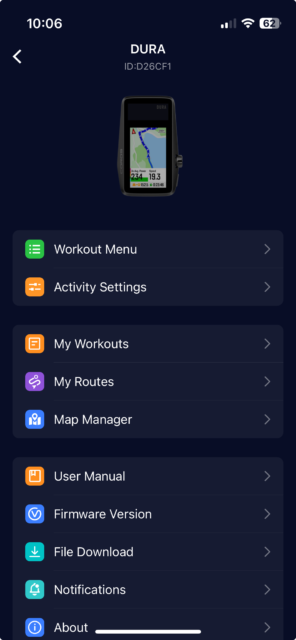
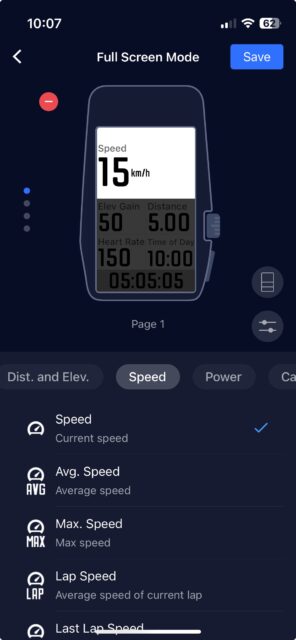
As a GPS-enabled computer, COROS provides the option to either see a full map in Full-Screen mode or to see a combination of a map and just a few key statistics in Split Screen mode. I found myself using both, often relying on Split Screen when I was truly using navigation features. It’s fairly easy to toggle between the two either when starting an activity or once an activity is already underway.
From a compatibility perspective, I had mostly positive results in pairing the Dura with other devices. I don’t typically ride with a power meter, but I was able to get it to pair with one without issue. My experience pairing with my Shimano Di2-equipped Gravel bike was easy, and I could set up the Dura to display my current gear configuration. The TQ HPR50 motor on the Trek Slash+ also paired seamlessly, showing battery life, assist mode, and other details on the Dura. My personal eMTB’s Shimano EP8 motor, however, didn’t appear to be compatible with the Dura, with the COROS pairing confusing the motor for a Di2 shifting system. I can’t confirm whether that’s a COROS or a Shimano issue, but it’s worth noting for fellow eMTB riders.
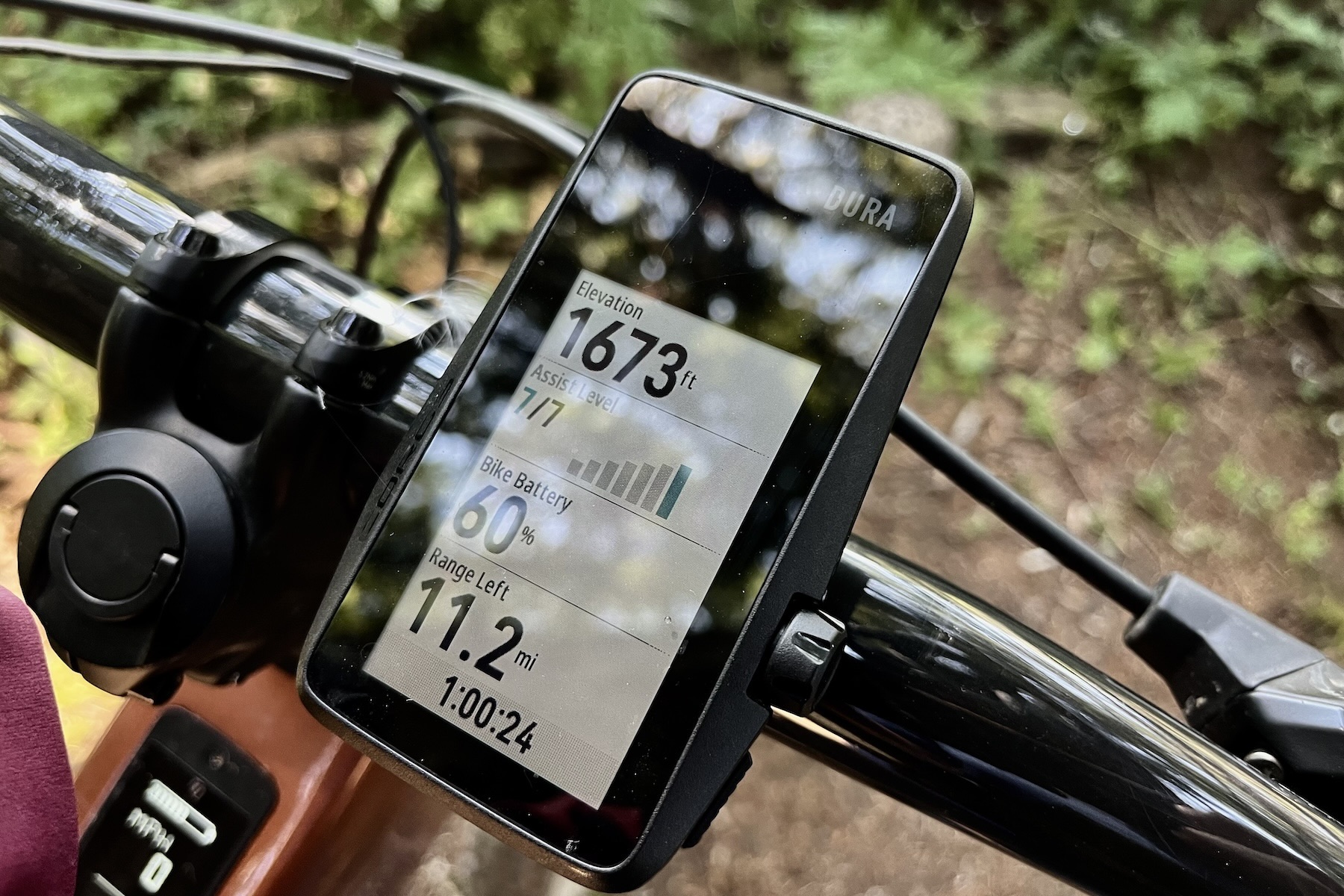
Mapping & GPS
My mapping experience was a tale of two halves — first with the pre-launch firmware, and then with the post-launch version that I received in July.
First, let’s talk about the pre-launch firmware, which received several updates during my testing up until July when the public launch firmware was made available. The timing worked out nicely with my receiving the Dura a few weeks ahead of a weeklong trip to Whistler, Pemberton, and Vancouver Island. A friend and I were riding a bunch of trails I’d never ridden before, and it seemed like a great opportunity to test the Dura’s mapping capabilities as we tried to untangle the spaghetti mess of trail options in each of our riding destinations.
I won’t dwell too much on the performance of the pre-launch firmware given that folks will not be getting that version with any new Dura, but suffice it to say it was a bit disappointing — particularly around navigation. Across all activity modes, navigation along a route proved less than intuitive — particularly when re-routing. While I had varied experiences here with how and where things went wrong, the simplest sequence of events that led things awry was (1) the Dura being late to recognize a missed turn, and (2) the Dura then getting confused with how to re-route, or simply providing a vague, point-to-point dotted line as the return-to-route solution. It was so bad in a couple of instances that I simply turned off the navigation until I had returned to the intended route, then restarted the navigation once I was back on track.
Fortunately, the July release of the public launch firmware drastically improved navigation. Navigation was updated to be faster in every regard, both in terms of recognizing the need to re-route and also in generating a new suggested route. Those routes generally proved accurate, and the Dura was far less likely to get confused when I strayed from the original path. Straying from that path also became less common with alerts showing up several hundred feet before a required turn — though it would be nice if COROS would include the name of the next road or trail rather than just a directive to “turn right”. Regardless, the updated guidance made it much easier to keep my rides flowing nicely without needing to slow down or think too much about my next move along the route. The issue of the underlying Google-based map often not recognizing trail names and the like did make for continued frustrations in use for mountain biking, but mapping and navigation for Road and Gravel use cases proved much, much better than in earlier firmware versions.
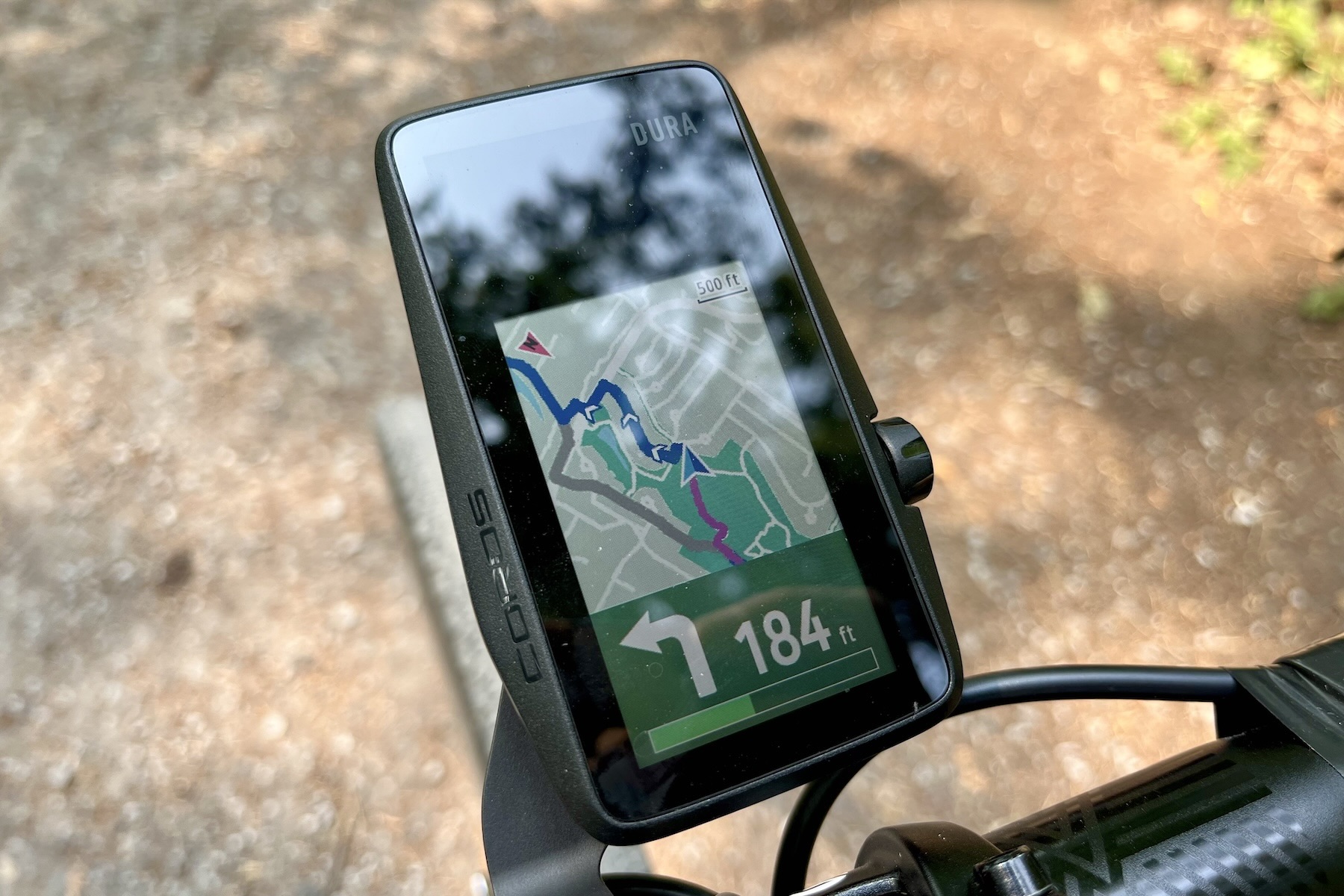
Our presentation from COROS at the time of launch made it fairly clear that the Dura was primarily designed with endurance, multi surface cycling in mind. While that certainly extends to Road and Mountain riding, my honest impression is that COROS was primarily targeting the ever-growing Gravel crowd — and you can feel that focus in the user experience around mapping.
COROS relies on Google Maps as its default base map. While this is great for navigating urban areas and Google-recognized trails like fire roads and more heavily trafficked trails, it presents some challenges for mountain bikers who have become dependent on TrailForks. Whereas Garmin has TrailForks compatibility to get all TrailForks-recognized trails and trail names right on your device, the COROS experience requires still using the TrailForks app to plan your route, then exporting the GPX file from TrailForks and uploading it to COROS for navigation. That’s fine for riding specific trails, but it means that more impulsive riding in a new zone will still require pulling out TrailForks on your smartphone to see all trails in a given area, trail names, and other details. I also found that exporting maps from TrailForks to COROS omitted elevation data. That meant that uploaded routes would show the distance remaining, but nothing about the elevation remaining.
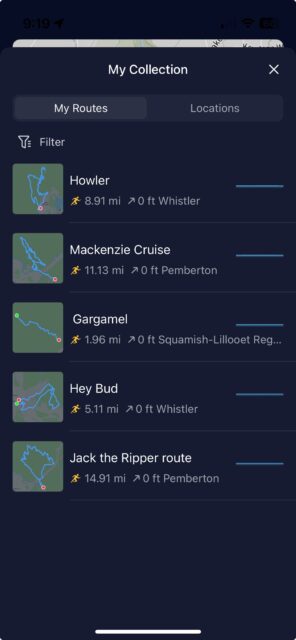
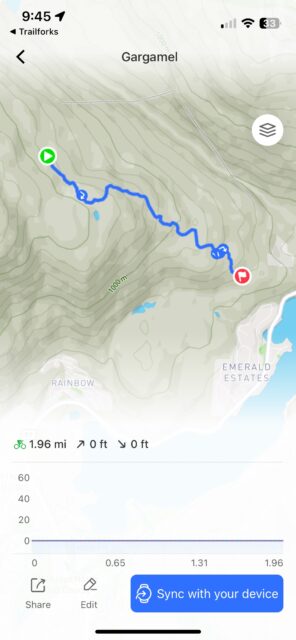
That same lack of support for TrailForks also meant that, at least while mountain biking, the manual route planner function in the Explore section of the COROS app was of limited use. You can manually draw maps to some extent if you know where things are, or if the trail happens to be recognized on Google like some of the more popular ones on Mt. Galbraith here in Bellingham, but in pretty much all cases it was vastly easier to just use TrailForks.
To be fair, my clunky mapping experience with the Dura mostly applies to mountain biking, where Google Maps as a base map doesn’t make as much sense. For Road and even Gravel riding, which often includes actual streets or at least fire roads and trails recognized by Google, it was much easier to use the native maps to understand where I was in a given ride. This also meant that I could use COROS’ built-in map creation features in the Explore section of the app to create routes, which could either be drawn manually or generated by selecting start and end points, with the option of adding waypoints in between.
From a GPS accuracy perspective, I found the Dura to be quite impressive in both single-band and dual-band GPS modes. I primarily used single-band GPS for the massively better battery life, and because I rarely had issues with accuracy. The computer’s ability to auto-select the optimal satellite resulted in a snappy GPS lock-on when I was ready to start a ride, and a closer look at maps showed good route adherence even in heavily forested areas. I’m not overly bothered by occasional hiccups in tracking accuracy, but the Dura had very few of those compared to other devices I’ve tried.
Battery Life
This is, in my opinion at least, the biggest selling point for the Dura. COROS promises 120 hours of battery life for single-band GPS mode or 70 hours in the more power-hungry dual-band mode. This is muddied by the inclusion of the solar panel which does replenish the battery somewhat during use, but suffice to say that the Dura offers a huge amount of battery life.
I didn’t measure battery life down to the hour, but I can say that during my summer of testing the Dura, I was able to use the computer three times or more per week for over two months without charging it. That’s fairly remarkable.
There are a few caveats to consider. I did notice faster battery drain while using navigation versus simply tracking my stats, but it was rather slight, with equivalent rides ending with 1-2% lower battery when using navigation relative to when I didn’t. Also, we did have some rather sunny weather in the Pacific Northwest during that period, so the solar panel was likely replenishing things more quickly than it would in other parts of the year. Was I getting the claimed solar efficiency of two hours of charge per hour of sunlight exposure? No, I think that’s a bit of an over-sell, especially since there are so many variables that can impact sun exposure over the course of a ride. But regardless of the exact battery claims, the Dura offered battery life that is far beyond any other device I’ve used for tracking my rides.
On the Trail
I covered a lot of the navigation and mapping considerations in the earlier section, so I’ll focus here on the Dura’s performance on more typical rides where navigation wasn’t necessarily required.
As a heads-up display for my ride statistics, the Dura was rather unobtrusive. It does have a larger footprint than some other cycling computers, but the screen was easy to read in both bright and low light, and having at-a-glance access to customized views for my chosen activity was rather nice for when I was looking to get a certain level of workout in, or if I was simply trying to make sure I got home on time. The Dura also displayed texts and phone call alerts, meaning that I could gauge whether a text or call was important without having to pull out my phone. Notifications can be disabled as well if you’re looking for solitude, but being able to see the first snippet of a text was a nice way to avoid having to check my phone if I felt a vibration.
Outside of navigation mode, the Dura offers two views — full screen and split screen. Full screen shows full pages of statistics for the chosen activity, whereas split screen shows just a couple of data fields at the bottom of the screen with a live map taking over most of the screen real estate. Both modes are fully customizable within the COROS app, allowing you to pick both the number of data fields to include in a given page as well as which fields to include. The choices are extensive, so riders should be able to have just about any metric they could want — I certainly never felt limited there.
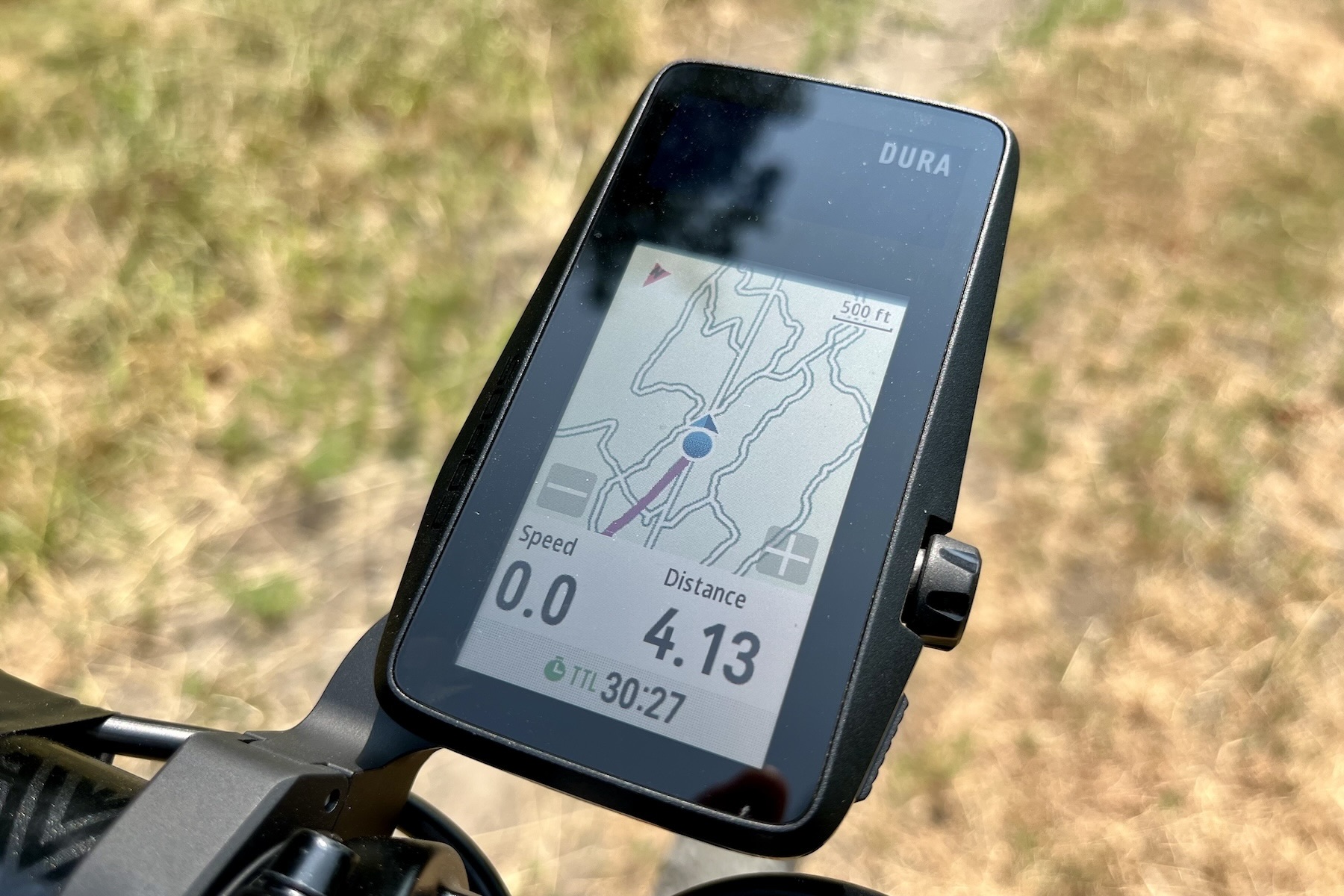
On the bike, I preferred full screen for more intensive training rides in order to keep track of all of my metrics, including heart rate provided by either my watch or the COROS heart rate strap, depending on which I was using. Split screen was particularly helpful when riding in new areas while not using navigation so that I could anticipate splits in the trail (or road) and reduce the need to stop or slow down.
One general gripe with the Dura experience is that a completed workout will not count towards any sort of fitness goals or factor into your fatigue guidance unless a heart rate monitor is worn. Unlike using a watch, there’s no inherent built-in heart rate sensor with the Dura, but it does feel to me like there should be an ability to approximately project performance and fatigue levels based on speed, distance, and elevation metrics captured by the Dura. There were rides where I forgot the heart rate monitor, and while I don’t follow fatigue guidance all that seriously, it can feel like a given ride “didn’t count” with respect to measures of recovery, fitness trends, etc.
I mentioned this earlier, but from a usability standpoint, the touch screen and digital dial controls of the Dura are not ideal for riding on any sort of rougher terrain. Changing modes feels quite fiddly, and scrolling between data screens is extremely difficult on the fly as the bike is getting bumped around. While no computer I’ve used is particularly user-friendly while riding off road, I can’t help but think that the Dura would be better served by single-function buttons rather than the digital dial, which requires more precise manipulation.
Who’s It For?
The Dura is an interesting first cycling computer from COROS, and like with COROS’ watches, the battery life is the big selling point in my mind. Riders keen on longer adventure rides or partaking in multi-day events will be very happy with the Dura’s ability to keep up with long days in the saddle without requiring charging. In its current state, the Dura’s hardware seems quite solid too, with a quality fit and finish for the $250 USD asking price that should appeal to value-oriented shoppers.
At the same time, the firmware elements feel a bit less polished, and I was fairly disappointed in the initial pre-launch firmware — it simply felt rushed to market. While the updated public release version of the firmware has fixed a lot of the initial issues, there’s still more work to be done to make it a more compelling option for off-road riders who aren’t likely to be fully satisfied with Google Maps’ capabilities. While COROS seems to be releasing a lot of smaller updates with a commitment to improving the user experience, it does mean that buyers will need to anticipate some initial shortcomings and quirks around navigation, particularly for off-road riding in less traveled areas, as COROS continues improving key parts of the Dura.
Bottom Line
COROS has delivered some very compelling wearable fitness devices in recent years, and the Dura feels like a thoughtfully designed product with some major differentiators in both battery life and price point. The experience still does not feel as polished as with COROS’ other devices or with many of the devices offered by COROS’ more established competitors, but our experience during the testing period suggests that COROS will continue to offer updates and continuous improvements. As a committed off-road cyclist, I think that the greatest opportunities for improvement lie in navigation and TrailForks compatibility, but for now, the Dura still remains a compelling, low-maintenance option for riders who can forgo some polish around the user experience in favor of truly impressive battery life.

Thanks for the review, helpful to hear the experience after the actual launch (instead of those early thought reviews which are abundant).
As a Dura owner and mountainbiker i do not agree on your take on ease of off road routing. Maybe my difference in experience comes from the fact that i live in Europe, but for me most single tracks are visible and routable in the Coros app. I believe the maps are not based on Google maps but on OpenStreetMap.
I have used the Dura to navigate me through unknown terrains throughout Europe (France, Italy, Switzerland, Germany) during my holidays and it served me very well. Obviously, the map does not reveal the actual nature of the tracks, but with the different lifestyles for off road, small tracks and even smaller tracks in combination with contour lines (elevation) I managed to discover many very nice trials (on some the blackberries took control, but you cannot blame Corps/OpenStreetMap).
Obviously, I would not mind integration of TrialForks, but I just want to mention I really liked the fast and easy way I could plan my bike adventures with the Dura. Sure there are some small improvements I will suggest to the team, but I am very happy with the functionality it brings as is.
Since the January update, the device has functioned perfectly. Navigation and rerouting have been spot on. In fact I prefer it to my Garmin 1040. The Nav on that is rubbish. It now sits in the drawer while the Dura is always first on the bike
Glad to hear the update has worked out well for you — I’ve been continuing to use the Dura since publishing my review and I agree that the recent updates have made significant improvements to the navigation. Re-routing, as you mention, is vastly better. While I still wish there was Trailforks integration for more on-the-fly trail exploration on trips to new riding areas, I’ve been glad to see COROS making continuous improvements.